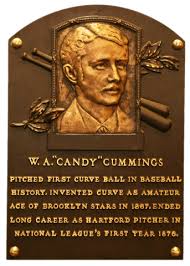The First Curveball
January 28, 2021
At the young age of seventeen, a right-handed pitcher would make his debut in the National Association of Base Ball Players, the first organization that served as a regulatory body for the relatively new phenomenon of American baseball. William Arthur Cummings was born on October 18th, 1848 in the small New England hamlet of Ware, Massachusetts. Ware was a formerly agrarian town that had transitioned to the textile industry largely over the course of Cummings’s own life. Despite this transition to industry, Cummings was still able to find simpler pleasures in Ware, such as throwing seashells and watching them move through the air and water.
Cummings began his career with Brooklyn’s Excelsior outfit, quickly becoming a star pitcher with the team. He earned the nickname “Candy” which at the time simply meant that he was the best at his job. In 1867, while with the Excelsiors, Candy threw the first curveball in baseball. At the time, catchers stood far behind the batter, making the majority of pitches with movement impossible to field. He worked with the catcher Nat Hicks, unique at the time for fielding from directly behind the batter, in order to create his curveball. In later interviews, he credited the seashells he threw as a young man in Ware and their unique motion as giving him the idea for the curveball. There is one other pitcher who claimed to have invented the curveball: Fred Goldsmith. Goldsmith claimed to have invented the curveball in 1870 even though Candy would have already thrown his curveball some three years earlier. In addition, the majority of sources at the time and historically have supported Candy’s claim to be the inventor of the curveball.
After his invention of the curveball, Candy was a highly effective pitcher in the National Association of Base Ball Players, the National Association, and the National League. He was also the first pitcher to win two complete games in one day, giving up only eight total runs in a grueling eighteen innings. Although the careers of players in this era were relatively short, pitchers played considerably more games and innings than they do currently. Candy, at the end of his career, possessed a 145-94 career record and a 2.49 ERA, incredible statistics for any era. In the middle of the 1877 season, he would resign as a player in order to serve as the president of the International Association for Professional Base Ball Players, at the time considered a rival to the National League.
After his term as President of the International Association, Candy would retire to a quiet life in Massachusetts. He earned a passive income from his invention of a railway coupling device, as well as managing a paint and wallpaper shop. On May 16, 1924, William Arthur Cummings died in Toledo, Ohio, at the age of 75. He was buried in his hometown of Ware, Massachusetts. For his invention of the curveball, Candy Cummings was inducted into the Baseball Hall of Fame via a special committee in 1939.


